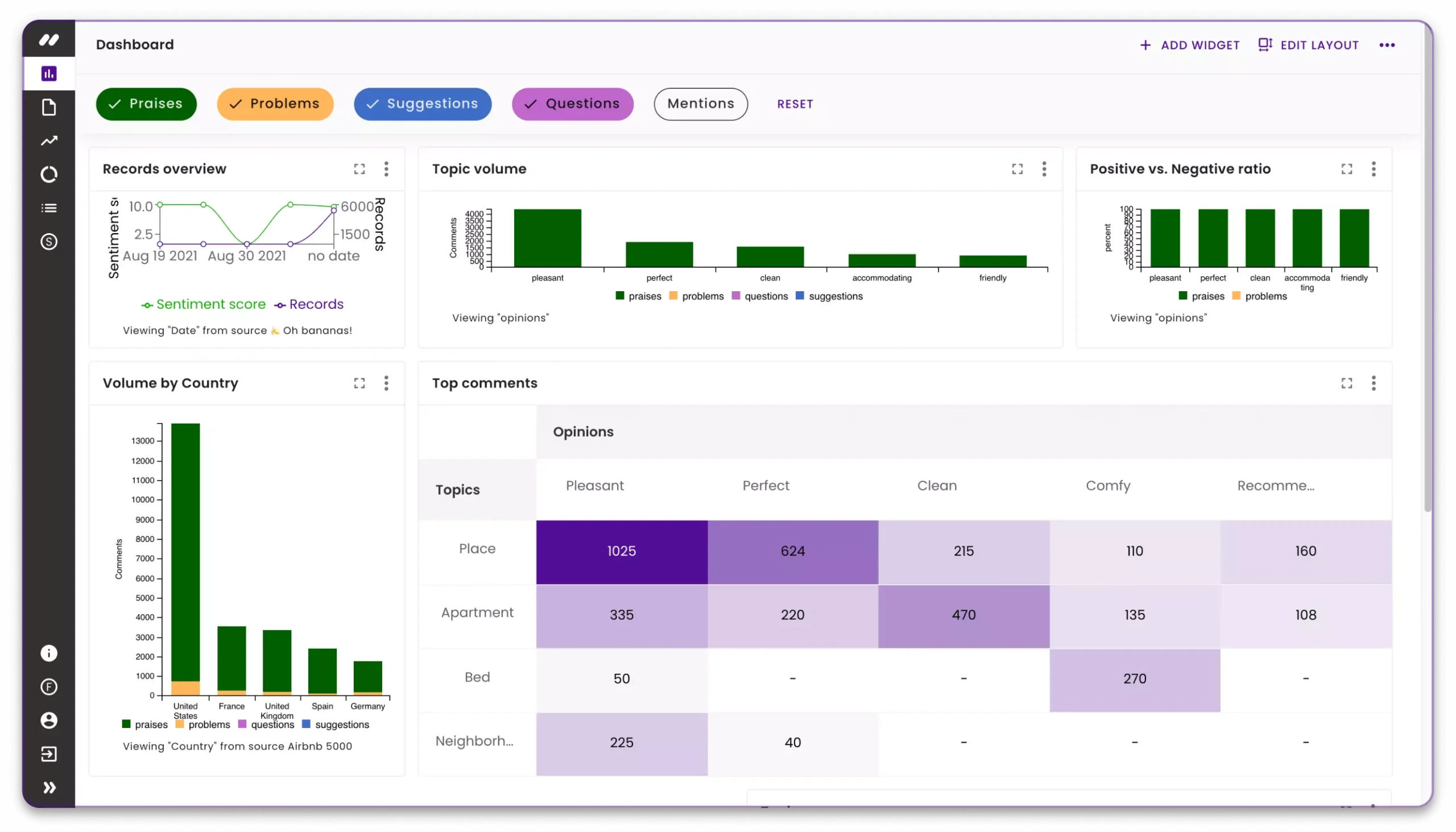Despite how normalized automation has become in people’s everyday lives—from bank machines to AI chatbots—successful customer experience strategy still relies on the human touch. It just looks a little more high-tech than it used to.
Customer experience (CX) now combines digital and human connections, public and private interactions and, with the advent of text analytics technologies, qualitative and quantitative data. Yet as technology improves in areas like automation and self-service, improving the speed of transactions and personalizing experiences, customers still value being understood and treated as individuals with unique needs and emotions. When it comes to customer care, they’re looking for empathy and responsiveness above all.
Unlike customer service, which is about providing assistance to customers with the goal of increasing their satisfaction, customer care is about taking care of customers while they’re interacting with your brand. Just as CX has shifted towards a more personalized and emotion-based strategies in the past decade, customer care doesn’t make sales the bottom line. Customer care exists within a bigger-picture brand journey where individual needs, solutions and emotions reign.
A company that knows the patterns, likes and dislikes of their customers has the best chance of keeping them as customers.
“A company that knows the patterns, likes and dislikes of their customers has the best chance of keeping them as customers,” states business-community site Customer Think, pointing out that anticipating and meeting people’s real needs depends on analyzing all forms of customer data and feedback throughout the customer journey. Among the insights that AI data analysis can provide is when and how to intervene on a human level during that journey.
AI analysis is becoming integral to meeting customers where they’re at, whether they’re making a purchase online, booking a hotel by phone or browsing in a store. Analyzing the qualitative data that those customer interactions provide (such as customer comments on feedback websites) is key to understanding customers’ emotional needs, personalizing future interactions and strategizing for increased ROI.
1. Customer Care Is Adapting to the Age of AI
Today, customers connect with companies in multiple ways, following a complex journey of touchpoints and creating a trail of data with each interaction. They might leave a review on your company’s online store, comment on a feedback site such as TripAdvisor, chat with a customer service representative or fill out a survey in your weekly e-newsletter. Within that wealth of what data scientists call “unstructured data” is the answer to why customers make the choices they do—why they purchase a product, why they’re loyal to a brand, why they can be swayed by a competitor. AI text analytics for customer service untangles massive amounts of quantitative and qualitative data to reveal not only the logic and sentiments behind those “whys,” but the pathways that lead to them.
2. AI Analysis Is Becoming More Human
An MIT study of 25 years of artificial-intelligence research looked at 16,625 papers to figure out where AI is headed. While the term “artificial intelligence” dates back to the 1950s, the basis of AI has shifted over the years. Knowledge-based systems that used thousands of rules to encode human knowledge have given way to faster machine learning and the neural networks of deep learning—intelligent algorithm-based methods that use statistics to find patterns in data.
The current shift in AI is in reinforcement learning: AI that is trained through a process of discipline and reward.
Machine learning and deep learning mimic human thought and behaviours, and the data they’re fed is labeled or categorized. The current shift in AI is in reinforcement learning: AI that is trained through a process of discipline and reward. Rather than striving to duplicate human intelligence on a grand scale, reinforcement learning is about computers learning how to solve problems on their own. That’s where data science—and AI text analytics for customer service—comes in.
As the field of data science overlaps with deep learning, text analysis tools have become more powerful, using AI methods such as Natural Language Understanding to uncover valuable insights on people’s behaviour from data. Those insights, combining technological accuracy with human emotions, can be mapped back to CX and other business strategies and can inform critical business decisions. Reinforcement learning also hails a new era for predictive AI: powerful tools for building future business models that have a stronger chance of success due to the models’ foundation in accurate data analysis.
3. Customer Care Is More Personalized
As data science and human nature converge through AI, the near future of customer care begins to look more personalized, emotion-based and, ultimately, enjoyable. All the ways that customers connect with a company—through social media, feedback sites, direct messaging, chatbots, email, in person and on the phone—can be viewed through the lens of customer care. Companies like Keatext help improve customer care through a data-led process of personalization.
By capturing insights from all customer feedback and communication with a company, Keatext provides rich context for data that lets you:
- See what customers are saying and determine what they need.
- Understand the sentiment or “why” behind customer comments.
- Solve problems and offer solutions.
- Create more effective customer care overall.
- Uncover problems that your company didn’t already know about.
4. New Solutions Can Build Relationships with Customers
AI text analytics are playing a major role in reimagining customer experience as personalized, contextualized and dynamic. New AI tools are able to couple definitive and solution-focused quantitative data collection with qualitative customer feedback analysis, such as Keatext’s AI-powered insight generation. That technological advance allows brands to gather a diversity of unbiased data, make sense of every point in the customer journey, and accurately personalize customer experience at the individual level.
AI text analytics are playing a major role in reimagining customer experience as personalized, contextualized and dynamic.
At the same time, in their 2019 US Customer Experience Index, market research experts Forrester found that the majority of the 100 brands they ranked had stagnated in terms of CX improvement—and not one of them achieved an “excellent” designation for customer experience. Though most brands had recently improved their CX, they weren’t yet connecting emotionally with customers, even though “emotion plays a critical role in differentiating brands and has a bigger impact on brand loyalty than effectiveness or ease of use, regardless of industry.” Customers’ emotions aren’t only tied to products and services, either—customers form emotional opinions about companies based on their entire experience with the brand.
A positive emotional experience directly translates to brand loyalty, according to Forrester’s research. Creating experiences that reach a level of excellence depend on customer feedback: “It’s critical to understand the intersection of in-the-moment customer feedback and which CX drivers matter most to customers and your bottom line.”
5. Customer Care Fits into CX Strategy
Customer care is now more public and social (online and off) than ever: in that way, it’s become part of marketing. For that reason, data availability matters to customer care agents as much as it matters to marketers and CX strategists. Customers accustomed to interacting with brands publicly across several social media channels,and they’re direct messaging companies more than ever before: 80% of consumers engage with brands online and 54% of customers prefer social messaging for customer care. Phone, email and in-person customer care still matter to customers—and they’re a key part of customer retention and loyalty—but the rapid rise of online engagement points to a need for further investment in online customer care.
80% of consumers engage with brands online and 54% of customers prefer social messaging for customer care.
Addressing customer care is as an integral component of customer experience across platforms. AI text analytics for customer service can help solve answer questions and provide insights on:
- Customer care performance including its cost and reliability, as well as customer responses
- Previously unknown customer care issues such as technical problems with software, product flaws, a confusing online interface, gaps in your onboarding process for service representatives, or other issues
- Hidden causes of customer behaviour: Text analytics uncovers and accurately groups customer reactions that you might not even be looking for. Certain behavioural themes that arise from these groupings can then be linked directly to their causes.
- Why happy customers might not be loyal customers: By analyzing multiple sources of feedback, AI text analysis captures not just how customers feel in the current moment, such as when talking to a customer service representative, but how they felt before and after that interaction. While a customer might be happy on the phone or chat, so the rep logs their response as positive, AI text analysis can show how a customer feels about the entire brand, providing a bigger, more factual picture of customer sentiment.
AI text analysis for customer service can show how a customer feels about the entire brand, providing a bigger, more factual picture of customer sentiment.
AI data analysis enhances human interaction in CX because it captures aspects of customer psychology and helps solve the problem of empathy that so many bigger brands encounter. Putting an individual’s customer data history into the hands of anyone in customer care means they can ultimately provide personalized, more empathetic care. And data gathered from customer care experiences taps into how people really talk and feel about a brand—it gets to the bottom of the conversation to understand why customers are loyal to a brand and why they might leave for another one.
How Keatext’s Text Analytics Provides Business Value and ROI
What differentiates Keatext’s AI text analysis is its strength as a tool that companies can use to accurately measure KPIs and ROI. The way Keatext analyzes both quantitative and qualitative data puts customers and the customer space at the centre, letting companies follow and understand both the customer journey and how it correlates to numbers, metrics and revenue. Keatext contextualizes historical data from multiple customer touchpoints, so its relevance crosses all departments within an organization.
Through deep text analysis, Keatext shows direct correlations between where revenue is coming from, problems related to revenue streams, and how to solve those problems. You’ll see both the cost of the problem and the cost of fixing the problem.
Keatext uncovers insights in data that reveal the emotional, completely human side of customer behaviour along with its direct, measurable correlations to revenue.
Survey-based tools such as Net Promoter Score attempt to put a number on customer loyalty and satisfaction through predetermined questions that don’t necessarily address a customer’s real concerns. Because it lacks crucial data, NPS doesn’t always translate back to sales. By contrast, Keatext’s analysis is based on customer feedback from multiple sources, from quantifiable customer metrics to qualitative open-ended questions from customer care representatives. The qualitative data gets to the reasoning and emotion behind customer feedback—and it’s linked to metrics too. By its detailed, data-rich nature, AI text analysis traces out the path to sales numbers.

And what about measuring the cost and value of Keatext itself to your business? The massive data aggregation capabilities of Keatext’s tools go beyond human abilities to provide a level of data analysis and insight that is accurate and predictive of ROI, letting you strategize around those numbers.
Customer care plays a key role in the bigger data picture for companies: it provides a wealth of quantitative and qualitative data and is an empathetic meeting ground for brands and customers. Sophisticated analytics tools like Keatext uncover insights in data that reveal the emotional, completely human side of customer behaviour along with its direct, measurable correlations to revenue. That combination of data lets you not only create stronger customer experience strategies, but also make company-wide business decisions backed up by clear connections between customer behaviour and ROI.


